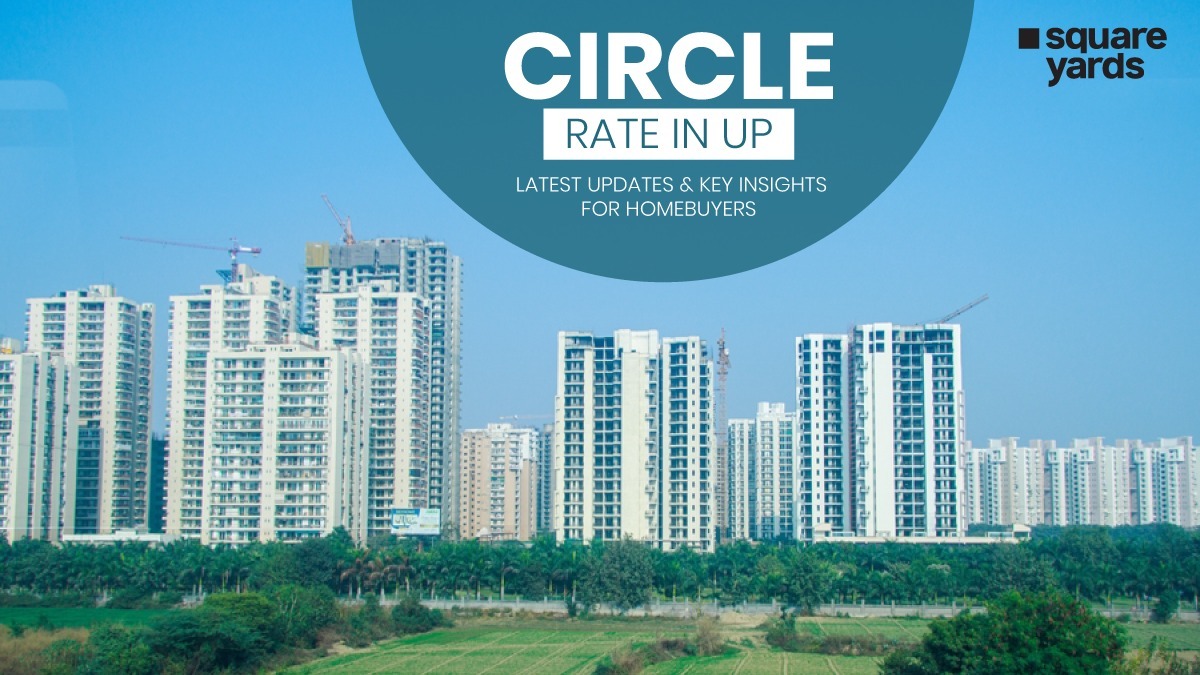Uttar Pradesh, India's most populous state, has over 20 crore residents, and it is a diverse mix of historical, cultural, and economic hubs. Cities like Varanasi, Agra, Mathura, Lucknow, and Prayagraj attract millions of tourists while serving as key commercial and residential zones. Given its rapid urban expansion, infrastructural advancements, and growing investment opportunities, UP’s real estate sector is witnessing significant growth. However, before purchasing any property, it is important to understand the circle rate in UP and any city.
Table of contents
Circle Rate in UP: Overview
The circle rate in UP is the minimum property value the state government sets for real estate transactions. It is the benchmark for calculating stamp duty and registration charges, ensuring transparency in property dealings. These rates vary based on location, property type, and market conditions, with higher rates in prime urban areas like Lucknow, Noida, and Ghaziabad than in rural regions. The government periodically revises these rates to align with market trends and revenue goals. Checking the UP circle rate list is necessary for homebuyers, sellers, and investors, as undervaluing property below this rate can lead to legal and financial implications. Always check the latest UP circle rate list before finalising a real estate transaction in UP.
Current Circle Rate UP: Key Factors
Circle rates in Uttar Pradesh (UP) are influenced by various economic, infrastructural, and market-driven factors that determine property valuation for stamp duty and registration charges. Here are the key factors affecting current circle rates in UP:
- Location and Demand: Due to increased demand, circle rates are higher in prime areas of cities like Lucknow, Noida, Ghaziabad, Kanpur, and Agra. Rural and less developed regions have lower rates due to limited infrastructure and lower buyer interest.
- Property Type: Residential properties generally have lower circle rates than commercial or industrial properties. Agricultural land has the lowest circle rates, but they vary depending on its proximity to urban zones.
- Infrastructure and Connectivity: Properties near metro stations, expressways, and highways (e.g., Yamuna Expressway, Lucknow Metro, Agra-Lucknow Expressway) have higher circle rates. Locations with upcoming flyovers, railway stations, and airports witness periodic hikes in circle rates.
- Government Revisions and Policies: The UP government periodically revises circle rates to reflect economic conditions and enhance revenue collection. Certain affordable housing zones may receive relaxations or exemptions.
- Market Trends and Real Estate Growth: If property sales and investments increase in an area, the government raises the circle rate to match market growth. Areas with upcoming real estate projects, IT hubs, and commercial centres see consistent rate hikes.
- Stamp Duty and Revenue Collection Targets: The government adjusts circle rates to maximise stamp duty collection and prevent transaction undervaluation. In high-value regions like Noida, Ghaziabad, and Lucknow, circle rates are adjusted to match rising property transactions.
- Local Municipality and Zoning Rules: Circle rates may vary within a city due to municipality classifications (e.g., core city vs. suburban zones). Areas designated for commercial or mixed-use purposes have higher rates than purely residential sectors.
Following is the UP circle rate list based on the top cities of UP and their popular localities:
| City | Locality | Circle Rate (per sq. meter) |
| Lucknow | Chinhat Village to Satrikh | ₹14,000 |
| Sultanpur Road and Shaheed Path | ₹25,000 | |
| Hardoi Road | ₹20,000 | |
| Chinhat Village Limit to Lucknow City Limit (Faizabad Road) | ₹30,000 | |
| Hazratganj Chauraha to Kalidas Marg Chauraha | ₹76,000 | |
| Kanpur | Sarsaul Village Limit to Kanpur City Limit | ₹6,600 |
| Ashrafabad Road | ₹13,200 | |
| VIP Road (Meghdoot Chauraha to Elgin Mill Chauraha) | ₹33,800 | |
| GT Road | ₹55,000 | |
| Mall Road | ₹66,500 | |
| Noida | Sectors 14A, 15A, 16, 17 (roads wider than 24 meters) | ₹1,19,000 |
| Sectors 15, 19, 20, 21 (roads 18-24 meters wide) | ₹79,200 | |
| Sectors 1-12, 22, 42, 43 (roads 12-18 meters wide) | ₹55,150 | |
| Sectors 66, 102, 138, and 139 (roads up to 12 meters wide) | ₹40,000 | |
| Agra | Lohamandi Chauraha to Bodla Chauraha | ₹35,000 |
| Madiya Katra Chauraha to Lohamandi Chauraha | ₹35,000 | |
| Hanuman Nagar Chauraha to Awadhpuri Tiraha | ₹28,000 | |
| Vayu Vihar 100 Road, Bodla Bichpuri Road Chauraha to Agra Fatehpur Sikri Road | ₹15,000 | |
| Ghaziabad | Kaushambi (roads over 18 meters wide) | ₹79,200 |
| Indirapuram (roads 9-18 meters wide) | ₹69,300 | |
| Vasundhara (roads up to 9 meters wide) | ₹56,000 | |
| Meerut | Delhi Road | ₹11,323 per sq. ft. |
| Meerut Bypass Road | ₹11,361 per sq. ft. | |
| Shatabdi Nagar | ₹6,666 per sq. ft. | |
| Rohta Road | ₹4,417 per sq. ft. | |
| Prayagraj | Civil Lines | ₹3,941 – ₹9,655 per sq. ft. |
| Kalindipuram | ₹4,440 – ₹6,071 per sq. ft. | |
| Jhusi | ₹1,111 – ₹4,024 per sq. ft. | |
| Naini | ₹2,083 – ₹4,370 per sq. ft. |
Note: Circle rates are subject to periodic revisions by the Uttar Pradesh government. For the most current and detailed information, it is advisable to consult the official Stamp and Registration Department of Uttar Pradesh or visit the respective local sub-registrar offices.
Calculate Property Value for Stamp Duty Payment
Stamp duty in Uttar Pradesh is calculated based on the higher value between the circle rate (government-mandated minimum rate) and the actual transaction price of the property. Follow these steps to find out the property value for stamp duty payment:
1. Identify the Applicable Circle Rate
- Visit the Stamp and Registration Department of UP website: igrsup.gov.in
- Select the district, tehsil, and locality to find the circle rate per square meter for your property type (residential, commercial, industrial, or agricultural).
2. Calculate the Property Value Based on Circle Rate
Formula:
Property Value = Circle Rate per sq. meter × Total Area (in sq. meters)
Example:
- If the circle rate for an area is ₹50,000 per sq. meter
- The property size is 100 sq. meters
Property Value= 50,000×100= ₹50,00,000
3. Compare with the Market Value
- If the negotiated price is higher than the circle rate value, the stamp duty is calculated on the higher value.
- The circle rate value will still be used if the market price is lower.
4. Calculate the Stamp Duty Payable
Stamp duty rates in UP (for 2024-25):
- Male Buyer: 7% of property value
- Female Buyer: 6% (includes 1% rebate)
- Joint Ownership (Male + Female): 6.5%
Example Calculation:
For a property value of ₹50,00,000:
- Male buyer: ₹50,00,000 × 7% = ₹3,50,000
- Female buyer: ₹50,00,000 × 6% = ₹3,00,000
- Joint ownership (Male + Female): ₹50,00,000 × 6.5% = ₹3,25,000
5. Additional Registration Charges
Apart from stamp duty, registration charges are usually 1% of the property value in UP.
Final Cost Calculation Example:
- Stamp Duty (Male Buyer) = ₹3,50,000
- Registration Fee (1% of ₹50,00,000) = ₹50,000
- Total Cost = ₹3,50,000 + ₹50,000 = ₹4,00,000
Other Cities Circle Rate
| Circle Rate in Noida | Noida Circle Rate |
| Circle Rate in Greater Noida | Greater Noida Circle Rate |
| Circle Rate in Ghaziabad | Ghaziabad Circle Rate |
| Circle Rate in Lucknow | Lucknow Circle Rate |
| Circle Rate in Delhi | Delhi Circle Rate |
How are Circle Rates Different from Market Rates in UP?
Circle and market rates in Uttar Pradesh (UP) serve different purposes in real estate transactions. The circle rate in UP refers to the minimum property values the state government sets for taxation and registration purposes. These rates ensure transparency in property dealings, prevent undervaluation and determine stamp duty and registration charges. UP circle rate list varies by location, property type, and amenities, and it is periodically revised based on government policies. However, these rates do not always reflect the actual demand for properties in a given area, as they are often lower than the prevailing market trends.
On the other hand, market rates are determined by real-time demand and supply in the real estate sector. Infrastructure development, proximity to commercial hubs, and future growth potential influence market prices. In rapidly growing cities like Noida, Ghaziabad, and Lucknow, market rates are often higher than the circle rate in UP due to private negotiations, investment trends, and premium property offerings.
The gap between the circle rate in UP and market rates is more significant in prime locations, where demand outpaces government-set valuations. This gap impacts property investment decisions and taxation calculations.
How to Check Circle Rate in UP?
To check the circle rate in Uttar Pradesh (UP), follow these steps:
1. Visit the Official Website
The Uttar Pradesh government provides an online portal where users can check circle rates for different localities.
- Go to the Stamp and Registration Department of UP website: igrsup.gov.in
2. Select the Relevant Option
- Click on "जनपदवार सर्किल रेट देखें" (Check Circle Rates by District)
- Choose your district, tehsil, and village/area from the dropdown menu.
3. View and Download the Rates
- The system will display the applicable circle rates for residential, commercial, industrial, and agricultural properties.
- You can download the information for reference.
4. Offline Method
- You can also visit your district's local sub-registrar office (SRO) to get official copies of circle rates.
Circle Rate UP: Contact Details
For inquiries related to circle rates in Uttar Pradesh (UP), you can contact the Stamp and Registration Department at the following address:
Revenue Council Building, Civil Lines, Allahabad
Phone: 0532-2623667
Fax: 0532-2623683
For additional assistance, you may also reach out to the Stamps and Registration Department:
2nd Floor, Office of the Inspector General of Registration, Allahabad, Uttar Pradesh
Phone: 0532-2623667
FAQ's about Circle Rate in UP
Circle rate of an apartment Part of the land ratio x land cost + flat area x building cost + common area x construction cost
You can find the circle rate of land in UP by visiting the Stamp and Registration Department of UP website (igrsup.gov.in). Select your district, tehsil, and locality to view the applicable rates. You can also visit the local SRO for official records.
To calculate the market value of a property in UP, multiply the circle rate (per sq. meter) by the total area of the property. If the actual sale price is higher than the circle rate value, the market value is based on the higher amount. You can check the latest circle rates on the Stamp and Registration Department of UP website (igrsup.gov.in).




